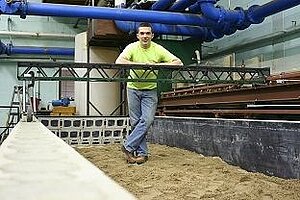Physical model evaluations of scour holes below a singular and multiple step rock weirs

Brian Mager is an M Eng. student in Civil Engineering majoring in Water Resources Engineering at the University of North Dakota (UND). Brian graduated with honors with a B.S. in Civil Engineering in May of 2012 through UND. Currently he is working on research supervised by Dr. Howe Lim in conjunction with a small community to evaluate solutions for wide spread streambank erosions.
701-317-1516
brian.mager@my.und.edu
Fellow: Brian Mager, Civil Engineering, UND
Advisor: Dr.Howe Lim, Civil Engineering, UND
Degree Progress: M.E.
Physical model evaluations of scour holes below a singular and multiple step rock weirs
During the last 15 years, rock weirs have become increasing popular hydraulic designs in the Red River Valley. However, very little research has been conducted as to the design parameters of rock weirs. Once constructed, rock weirs begin to form a scour hole downstream which if not properly designed will undermine the foundation of the rock weir, leading to failure of the site. Existing research has been limited to singular weir structures and doesn’t evaluate the effects of stepped weirs to aid in downstream scour reduction.
Through a large scale sediment flume construction at the University of North Dakota a 1:5 scale model is being used to evaluate the severity of these scour holes. For this analysis a fine granular bed material was chosen that best represented local non-cohesive soil conditions. A typical U-shaped rock weir will be evaluated for scour as a control and compared to multiple rock weirs of the same shape in series. The spacing between the weirs will be varied and analyzed to determine optimum design parameters to reduce scour, given various volumes of flows and tailwater conditions. This will be vitally important to the small communities that compose the Red River Valley by providing the best design criteria at the most effective cost of construction.
After data collection has been attained GIS software will be used to visually analyze and mathematically calculate areas of scour to determine the optimum layout parameters.
Progress:
Construction of a four thousand gallon concrete block flume, hydraulic conveyance piping and an XYZ measurement system are completed. The rock weir design has been chosen and a physical model has been constructed with a concrete base. Currently various simulations are being ran. Physical dimensions of the structure are 26 ft long 7 ft wide and 3 ft height. Dimensional analysis has been conducted on the variables responsible for rock weir erosion and theoretical research has also been completed.
Thesis:
Physical Model Studies of Scour Holes Below Singular and Multiple Step Rock Weirs

Lim Yeo Howe
Civil Engineering
Upson Hall II Room 260D
243 Centennial Drive Stop 8115
Grand Forks, ND 58202-8115
Phone: 701-777-3998
Email: yeo.lim@und.edu


